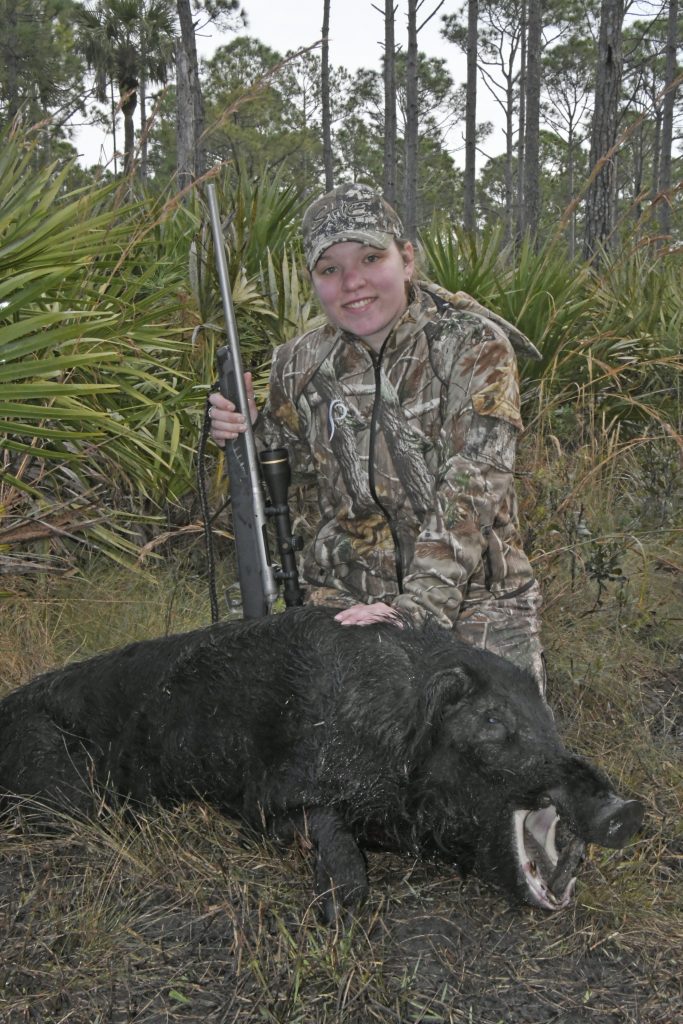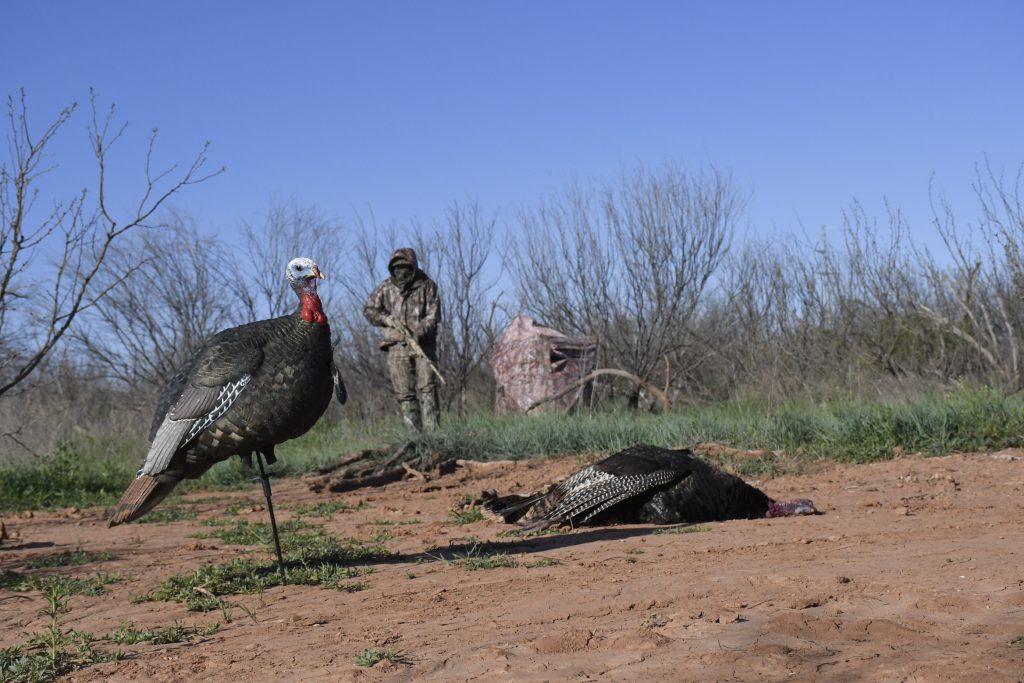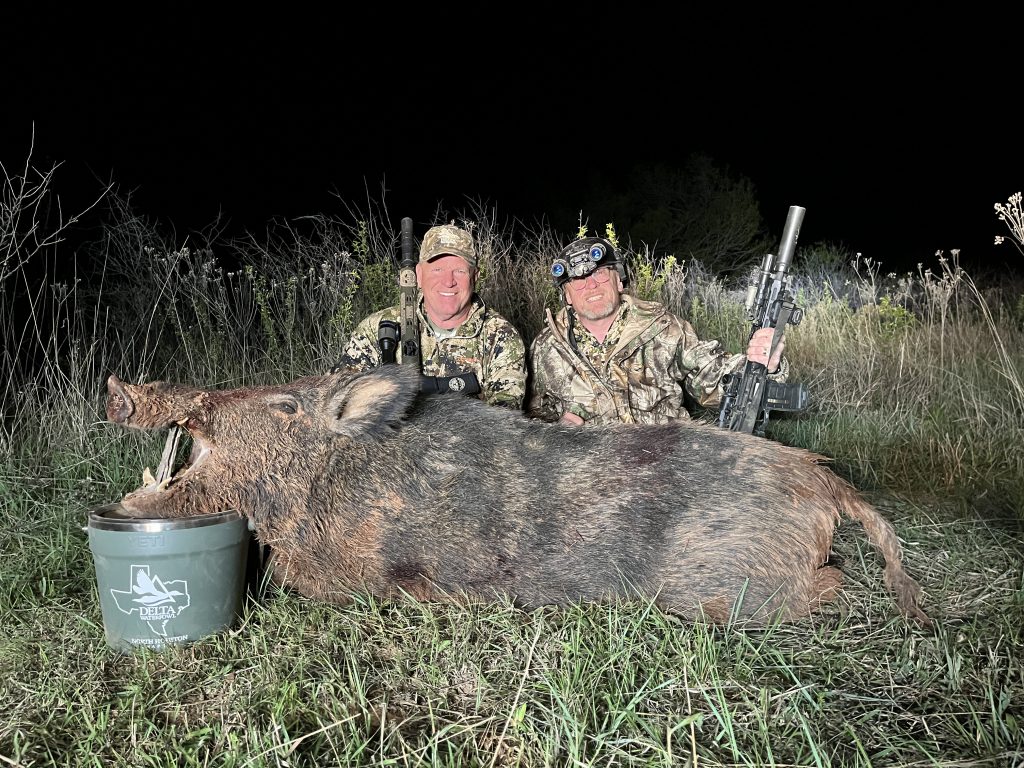Hogs Provide Hunting Opportunities for Turkey Hunters
While research shows hogs have little impact on wild turkeys and their nests, they do compete for food resources and create chaos on the landscape.

Turkey hunting is such that it’s often boom or bust.
When it’s boom, a hunter tagging out early can be left with a lot of time on his or her hands. Hunting hogs can help fill that void. The range of states with high hog numbers overlap some prime turkey hunting areas. Two states – Texas and Florida – are standouts as far as hog numbers and are also prime spots to stroke off two of the necessary sub-species for a Grand Slam.
Hunting in Texas this spring, I found myself in the scenario described above where I notched tags early. Meeting up with Shane Arrant in Texas in late afternoon, we headed out to his hunting lease on the Circle Bar Ranch shortly after I arrived.
Driving down a farm laneway to an area ahead frequented by turkeys, we set up adjacent to it. Visibility was limited to 50 yards on the other side of the path by the thick mesquite bushes. I settled in, using a bush for cover and finding a branch at the right height for a gun rest.
Arrant let out a few yelps on his glass pot call. I dug out my slate pot call, to add the illusion there was more than one turkey. A couple of minutes later he yelped again, and I echoed his yelps with a few of my own.
“A gobble,” he said. “I heard a gobble right after you called.”
Not a minute passed and there was another gobble. I set down my call, readying to shoot and Arrant yelped again. There was a response, closer this time, followed by a deep, slow yelp. Then I saw the light tips of a fan moving to the left in front of us through the mesquite and a turkey head weaving through the cover in front of the strutter. Not seeing the bright white head of a gobbler, I assumed the lead bird was a hen until it stepped out into the open about 35 yards away and I spotted the short beard of a jake. It made its way toward the decoy, and stopped short.
I kept my eyes on the fan moving through the bushes, finally seeing the tom appear where the jake had come in the clear a minute earlier. The tom stayed in full strut as it made a beeline for the jake decoy. Still in strut while challenging the decoy, I let a cluck out with my mouth call and its head went up. One shot from the 20-gauge anchored it 18 yards away, not 15 minutes after we arrived.
That night, after cleaning the bird, we cruised through the arid valleys carved into the red soil on Arrant’s side-by-side looking for hogs. We spotted one hog about 500 yards away, but it bolted as we drove closer.
The next morning, we set up in a flat adjacent to the North Wichita River, where Arrant had seen turkeys regularly. This area was more open, but there was a slight rise in the terrain in front of the blind we set up in.
Around 7:45 a.m., we first heard a single yelp. Arrant hit his glass call, and got another yelp. Then, things happened quickly. The yelps got louder and more frequent in front of us, and I heard a hen cutting to my right.
“They’re coming in hot,” I heard Arrant whisper before three hens ran down the slope in front of us, and then a larger hen came in from the right. Three minutes, became four and five as we watched the hens in front of us. Then, we heard a distant gobble. Arrant let out another yelp, eliciting another gobble. I scratched out a purr and a few clucks on the slate, which resulted in the hens answering with their own clucks and purrs.
The gobbles gradually became louder, and I saw a bird coming in from the left. Again, it walked up to the jake decoy, bumping it to challenge the fake. This time, the tom raised its head during the challenge, which was the last thing it did.

After two nights of sitting in a blind waiting for hogs unsuccessfully, we went high tech to hunt hogs after dark on the last night. Cameras showed a hog on the feeder in front of the blind I had left an hour before, but it bolted before we could get a clear shot after our stalk.
Trying this approach again at a different feeder, we were able to approach within 70 yards. I was using night vision gear with an infrared laser sight and dropped a 200-pound brute.
Another State, Another Approach

My first hog-hunting experience was a few months early in Florida. My daughter Abby and I hunted with Hunter’s Envy on its 3,250-acre ranch on the east coast of Florida, near Mims. Although we weren’t turkey hunting, Hunter’s Envy’s turkey packages include hog hunting.
“Most of the time if we’re hunting turkeys and a hog comes in, we’ll shoot it,” said Jonah Baker, guide and land manager.
Or, as Hunter’s Envy business and property manager Riley Ferguson explained, if the hunter gets a turkey early, they will hunt them like we were, waiting or stalking hogs at feeders. After an initial attempt waiting on a feeder in the dark which the hogs left before daylight, we moved to another feeder where cellular trail cameras showed hogs.
Abby was shooting first and Baker coached her after approaching within 100 yards and setting up a shooting stick.
“You hit it,” Baker said, after she shot the 6.5 Creedmoor with ELD-X hand loads.
The end result was a 150-pound hog. Hog hunting is complimentary to turkey hunting and an opportunity to control a feral species while having some fun.
Hogs, Turkeys and Habitat Destruction
Feral hogs, or wild boars, have been present in the United States since the 1500s when pigs raised for livestock escaped. Since then, they have interbred with wild boars brought from other continents for hunting.
There is a widespread misbelief that hogs are large predators of turkeys and their nests. While this can occur, it’s not on a large scale according to the latest research.
“There is zero credible evidence to support that assertion and we’ve seen no predation of birds themselves from pigs in any of our studies spanning the entire Southeast,” said Dr. Michael Chamberlain, professor and researcher at the University of Georgia.
Chamberlain reinforced this also applies to turkey eggs and nest predation, which is a more widely-held belief. A study in Texas showed hogs will predate nests, but Chamberlain said it was flawed as it used simulated nests with no hens present.
“Note that all the way back to the days of Lovett Williams, who studied birds in south Florida where pigs were abundant, there’s been almost no data showing pigs consume nests, except on rare occasions,” Chamberlain said.
He elaborated further saying generally in the spring turkeys are nesting in upland habitat and pigs are in wetter areas. Bobcats, coyotes, raccoons and snakes are significant nest predators.
“Turkeys have been dealing with feral pigs in many parts of their range and thrived for decades,” Chamberlain said. “There is potential pigs are degrading the environment and competing for food resources.”
Further research is looking into how turkeys and pigs use their habitat. Chamberlain said hogs degrade vegetative communities, compete with other species for food, disrupt soil horizons and root in the soil.
Annie Farrell, NWTF district biologist for Texas, Oklahoma, Kansas and Nebraska, agreed hogs and turkeys competing for the same resources is an issue.
“Wild hogs are an exotic invasive species that cause billions of dollars’ worth of damage to wildlife habitat and the agricultural industry in the United States,” she said. “This large-scale damage can affect wildlife populations and especially impact sensitive ecological areas and critical habitats for species of concern.”
With an estimated 2.6 million hogs in Texas, the damage to agriculture is significant enough that the Daniel family, who own the Circle Bar Ranch, assists with a hunt that uses helicopters to lower hog numbers. There are 6,500 acres of wheat, oats and hay in cultivation at the Circle Bar. Ranch founder Jerry Bob Daniel started seeing hogs on the ranch in the early 1980s after a few were released for hunting on a ranch several miles away. Hog numbers have grown since.
Colton Daniel, ranch general manager and part owner, said hogs can eat crops, bed in crops and root in the fields when the crops are young.
“If I didn’t shoot hogs, I could easily lose $50,000 to $60,000 just through hog damage,” he said.
A decision was made to take to the air to shoot hogs in 2015 and 800 were shot in two days from a helicopter. The next year, an affiliation started with a veteran’s group. That group has morphed into Big Country Veterans. Now, 1,200 to 1,400 are shot in two days from helicopters and then two to three weeks later, a clean-up hunt is held after the remaining hogs regroup.
Top Turkey-Hog Hunting Destinations
Texas and Florida are widely considered number one and two, respectively, for hog hunting due to population and hunting opportunities. They would also fall in that order for combination hunts when considering turkey hunting opportunities. Other top states, based on hog populations, turkey populations and availability of outfitters offering combination hunts or public land availability, are below.
Alabama: With 47,000-plus turkeys harvested in 2023, according to NWTF’s Spring Hunt Guide, and hogs present in all 67 counties, Alabama is a natural top state.
Tennessee: The state with the top turkey harvest in the nation has to make the list. Although it’s not as well known for its hog hunting, there are opportunities.
Georgia: With more than a million acres of public land, the opportunities for do-it-yourselfers are good in the Peach State. Both turkey and hog numbers are decent.
Oklahoma: Being next door to Texas, Oklahoma is bound to have good hog numbers. Turkey numbers are estimated at 70,000 of Rios and Easterns. One positive for Oklahoma is the 900,000-plus acres of public huntable land.
California: California often makes the top five list for hog hunting, and the state’s turkey population is decent, with about 20,000 harvested last year according to the hunt guide. On the negative side, hunting regulations for hogs are more restrictive than some states.
Notes on Feral Hog-Wild Turkey Interactions from the Wild Turkey Lab: https://wildturkeylab.com/the-explosion-of-feral-pig-populations/
Check out Dr. Mike Chamberlain’s Wild Turkey Lab, which the NWTF is a partner in developing, for more research and studies on all things wild turkey at https://wildturkeylab.com.
CONNECT WITH US
National Wild Turkey Federation
770 Augusta Road, Edgefield, SC 29824
(800) 843-6983
National Wild Turkey Federation. All rights reserved.